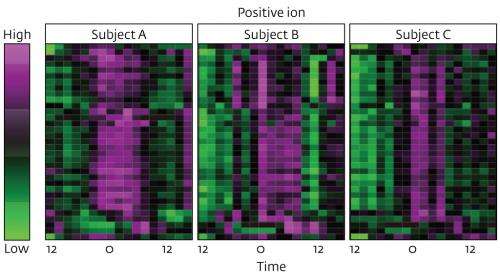A natural sense of rhythm: Shifting levels of molecules in the blood provide a snapshot of internal 'body-time'

Anybody who has worked the overnight shift will testify that sometimes the time displayed on the clock is not the same as the one in your head. This disconnect is not merely perception; many physiological functions follow an internal chronological rhythm. 'Body-time' can profoundly affect overall health and even the response to therapies for cancer and other disorders.
By charting rising and falling concentrations of molecules in the bloodstream, researchers led by Hiroki Ueda of the RIKEN Center for Developmental Biology in Kobe and Tomoyoshi Soga of Keio University have developed a first-generation 'metabolite clock' that enables easy monitoring of the human body's internal timetable.
"The goal of our study was to develop a method that would be available for clinical situations," says Takeya Kasukawa, a researcher in Ueda's lab and lead author on the study. Doctors can track physiological rhythms via changes in levels of the hormone cortisol, but this is a laborious procedure as subjects have to stay in the hospital for a few days and have blood taken every few hours. By using mass spectrometry—a technique for identifying and quantifying the various components within a mixed sample—Kasukawa and his colleagues were able to characterize temporal changes in levels of metabolic by-products in the blood.
The researchers had previously generated such a metabolite timetable in mice and attempted to replicate this success with six human volunteers. For a week, these subjects lived on a 28-hour cycle that desynchronized their internal time relative to the normal sleep/waking schedule. The researchers used blood samples collected from three of these individuals prior to the desynchronization process to generate a timetable, and identified dozens of metabolites whose levels shifted cyclically (Fig. 1). They then used these metabolite signatures to determine the post-desynchronization body clock in all six individuals.
The results proved remarkably accurate compared to conventional cortisol measurements, with a difference generally not exceeding a few hours, even with one subject whose body-time was especially disrupted relative to the others. Kasukawa expects that future iterations of this metabolite clock will achieve greater accuracy through the identification of new timetable molecules in the blood and more sensitive instrumentation.
However, even this first-generation clock allows reasonably accurate body-time estimation from only a few blood samples and the research team plans to push forward with clinical feasibility studies. "We are planning to apply our molecular timetable method to patients with sleep disorders or irregular circadian clocks," says Kasukawa.
More information: Kasukawa, T., et al. Human blood metabolite timetable indicates internal body time. Proceedings of the National Academy of Sciences 109, 15036–15041 (2012). www.pnas.org/content/early/201 … /1207768109.abstract
Minami, Y., et al. H.R. Measurement of internal body time by blood metabolomics. Proceedings of the National Academy of Sciences USA 106, 9890–9895 (2009). www.pnas.org/content/early/200 … /0900617106.abstract
















